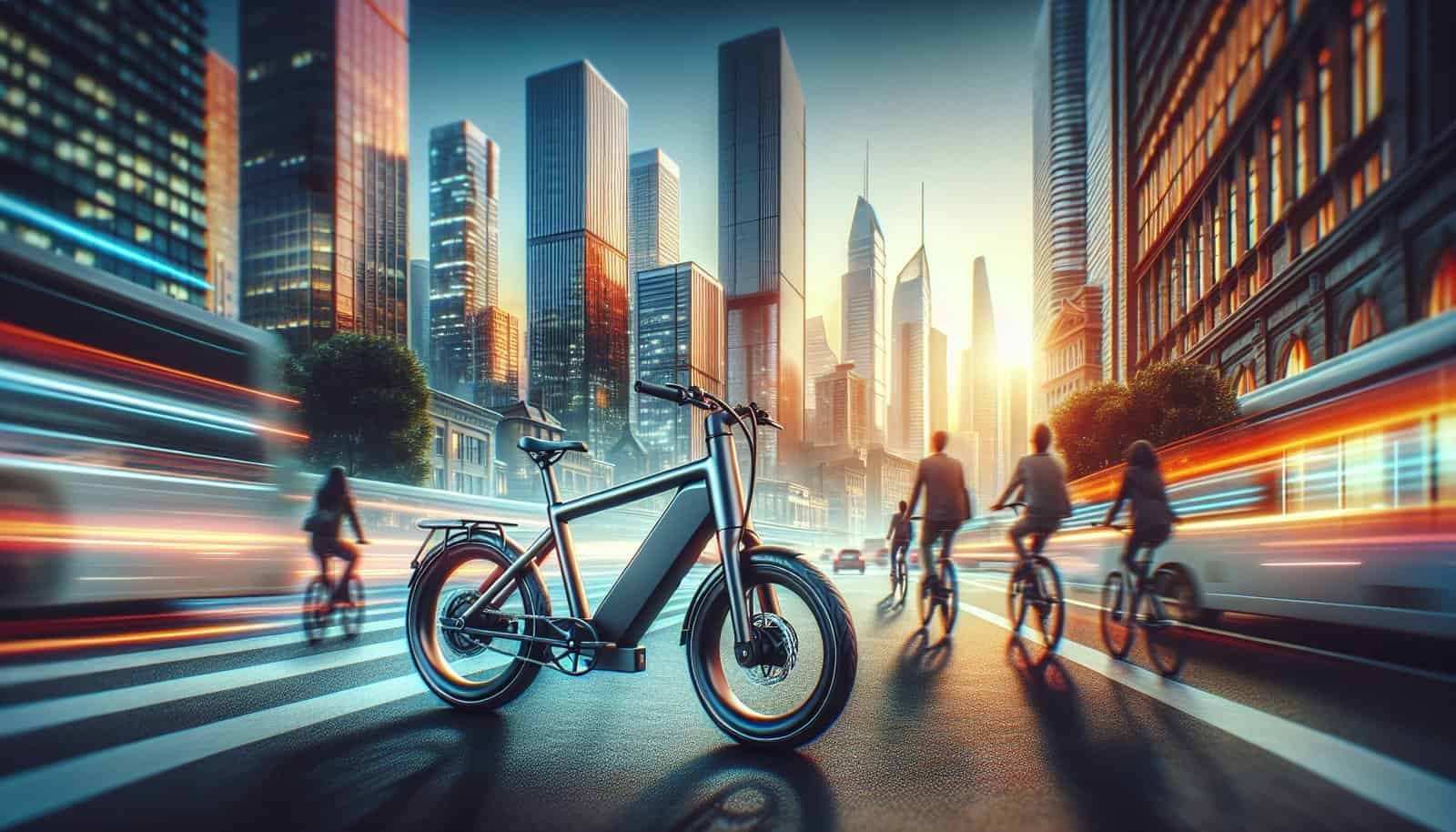Are you in the market for an electric bike but feeling overwhelmed by the options? Don’t worry, we’ve got you covered. In this article, we will guide you through the process of selecting the perfect electric bike to suit your specific needs, whether it be for commuting to work or simply enjoying leisurely rides on the weekends. With our friendly advice and helpful tips, you’ll be cruising around on your ideal electric bike in no time!
Consider Your Riding Purpose
When choosing the right type of electric bike, it is important to consider your riding purpose. This will help you identify the specific features and characteristics you should look for in an electric bike.
Identify Your Riding Purpose
First, think about why you want to ride an electric bike. Are you planning to use it for commuting to work or school? Do you want to use it for leisurely rides around the neighborhood or on bike paths? Are you looking for an electric bike for off-roading adventures? Understanding your riding purpose will help you narrow down the options and choose a bike that is well-suited for your specific needs.
Determine the Distance and Terrain
Consider the distance you will be riding on a regular basis. Are you planning to cover long distances or just short trips? This will help you determine the battery range you need in an electric bike. Additionally, think about the terrain you will be riding on. Will you mostly be riding on paved roads or do you need a bike that can handle rough trails and uneven surfaces? This will influence your choice of tires and suspension.
Consider the Speed and Power Needed
Think about the speed and power you need from an electric bike. If you plan on riding at higher speeds or tackling steep hills, you may want to look for a bike with a more powerful motor. On the other hand, if you will mostly be riding on flat terrain at lower speeds, a less powerful motor may be sufficient. Consider your comfort level with speed and the type of assistance you want from the electric motor.
Evaluate Your Riding Style
Understanding your riding style is crucial in choosing the right electric bike. Your fitness level, preferred riding position, and riding experience all play a role in selecting a bike that suits you best.
Determine Your Fitness Level
Be honest with yourself about your current fitness level. If you are not used to regular physical activity or have any physical limitations, you may want to consider an electric bike with higher levels of assistance. This will allow you to still enjoy riding without putting excessive strain on your body. However, if you are already fit and want to use the electric bike as a way to enhance your workouts, you may prefer a bike with multiple assistance levels or even a pedal-assist system.
Consider Your Preferred Riding Position
Think about how you typically like to ride a bike. Do you prefer an upright position that allows for a more relaxed ride? Or do you like a more aggressive riding position that offers better aerodynamics? Electric bikes come in various frame designs and handlebar styles that cater to different riding positions. It’s important to choose a bike that aligns with your preferred riding posture.
Assess Your Riding Experience
Take into account your level of experience with riding bikes. If you are new to biking or have limited experience, you may want to opt for an electric bike that offers stability and easy handling. On the other hand, if you are a seasoned cyclist looking for more advanced features and performance, a higher-end electric bike with responsive components may be more suitable. Evaluate your comfort level and skills to ensure a safe and enjoyable ride.

Choose the Right Electric Bike Type
Now that you have considered your riding purpose and evaluated your riding style, it’s time to explore the different types of electric bikes available. Each type offers unique features and benefits that cater to specific riding preferences.
City/Commuter e-Bikes
City or commuter e-bikes are designed for urban riding and transportation. They typically feature a comfortable riding position, fenders for protection from dirt and water, and integrated lights for enhanced visibility. These bikes are great for daily commuting to work or running errands around town.
Mountain e-Bikes
Mountain e-bikes are built for off-road adventures and trail riding. They come with rugged frames, wider and knobby tires for improved traction, and a suspension system that absorbs shocks and bumps. These bikes are perfect for tackling challenging terrains and exploring nature trails.
Folding e-Bikes
Folding e-bikes are compact and portable, making them ideal for commuters who need to take their bikes on public transport or store them in small spaces. They can be easily folded and carried, yet still offer the convenience of electric assistance.
Hybrid e-Bikes
Hybrid e-bikes combine the features of both road bikes and mountain bikes, making them versatile and suitable for a variety of terrain types. They offer a comfortable riding position, wider tires for stability, and smooth-rolling capabilities.
Road e-Bikes
Road e-bikes are designed for speed and efficiency on paved roads. They have sleek and lightweight frames, narrow tires for reduced rolling resistance, and a more aggressive riding position for improved aerodynamics. These bikes are perfect for riders who want to cover long distances quickly.
Cargo e-Bikes
Cargo e-bikes are specially designed for hauling heavy loads, such as groceries, packages, or children. They feature an extended rear rack or a front basket for carrying cargo, and often have a powerful motor to assist with the additional weight.
Step-Through e-Bikes
Step-through e-bikes have a low or no top tube, allowing riders to easily mount and dismount the bike. These bikes are popular among riders who have limited mobility or prefer a more convenient and accessible design.
Fat-Tire e-Bikes
Fat-tire e-bikes have wide, oversized tires that provide excellent traction and stability on soft surfaces like sand and snow. These bikes are perfect for riders who want to venture off the beaten path and explore rugged terrains.
Consider the Motor and Battery
When choosing an electric bike, the motor and battery play a vital role in determining its performance and range. Understanding the different options available will help you make an informed decision.
Motor Power
Electric bike motors come in various power ratings, typically ranging from 250 watts to 750 watts. The higher the wattage, the more power the motor can provide, allowing for faster acceleration and better performance on steep hills. Consider your riding purpose and the terrain you will encounter to determine the appropriate motor power for your needs.
Motor Placement
Electric bike motors can be found in different locations on the bike, including the front wheel, rear wheel, or mid-drive. Each placement has its advantages and disadvantages. Front wheel motors provide easy installation and balanced weight distribution. Rear wheel motors offer better traction and stability. Mid-drive motors provide a more natural riding experience and better weight distribution. Consider your riding style and preferences when selecting the motor placement.
Battery Capacity
Battery capacity is measured in watt-hours (Wh) and determines the range an electric bike can achieve on a single charge. Higher capacity batteries generally provide longer ranges but are also heavier. Consider the distance you plan to ride on a typical trip and choose a battery capacity that meets your needs without adding unnecessary weight.
Battery Type
Electric bike batteries usually come in two types: lithium-ion and lead-acid. Lithium-ion batteries are commonly used because they are lightweight, have higher energy density, and longer lifespan. Lead-acid batteries are less expensive but heavier and have a shorter lifespan. Consider the advantages and disadvantages of each battery type and choose the one that best suits your needs.

Evaluate Braking System
The braking system of an electric bike is crucial for safety and control. There are two main types of brakes to consider: disc brakes and rim brakes.
Disc Brakes
Disc brakes offer superior stopping power and performance, especially in wet and muddy conditions. They consist of a caliper that clamps onto a disc attached to the wheel hub. Disc brakes require less force to engage and provide reliable braking even on long descents or at higher speeds. They are highly recommended for riders who prioritize safety and require responsive braking.
Rim Brakes
Rim brakes, also known as V-brakes or caliper brakes, use friction pads to squeeze the wheel rim when the brake lever is pulled. They are lightweight, easy to maintain, and provide sufficient stopping power for most casual riders. However, rim brakes may be less effective in wet conditions and can wear down the rim over time. Consider your riding style and the terrain you will encounter to determine the most suitable braking system for your needs.
Examine Frame and Suspension
The frame and suspension of an electric bike determine its stability, comfort, and handling characteristics. Understanding the options available will help you choose a bike that suits your riding style.
Frame Material
Electric bike frames are commonly made of aluminum or carbon fiber. Aluminum frames are lightweight, durable, and more affordable. Carbon fiber frames are even lighter and offer increased stiffness and vibration damping, resulting in a smoother ride. Consider your budget, weight preferences, and desired ride quality when selecting a frame material.
Frame Size and Geometry
Choosing the right frame size and geometry is crucial for a comfortable and efficient riding experience. Electric bikes come in various sizes to accommodate riders of different heights. It is important to test ride different sizes to find the one that fits you best. Additionally, consider the frame geometry, which affects the riding position and handling characteristics. Some frames have a more upright position for relaxed riding, while others have a more aggressive position for better aerodynamics.
Suspension Type
Electric bikes may come with front suspension, rear suspension, or both. Front suspension forks absorb shocks and bumps, providing a smoother ride on rough terrain. Rear suspension, often found on mountain e-bikes, further enhances comfort and control by absorbing impacts from the rear wheel. Consider the type of terrain you will encounter and the level of comfort you desire when deciding on the suspension type.

Take Note of Additional Features
Electric bikes often come with additional features that enhance the overall riding experience. These features can vary depending on the bike type and brand. Consider the following factors when making your decision.
Lighting Systems
Some electric bikes come with integrated lighting systems, including front and rear lights powered by the main battery. This is particularly useful for commuting in low-light conditions or during the evening. Make sure the bike you choose has proper lighting if you plan on riding in dimly lit areas.
Gearing Systems
Gearing systems on electric bikes allow for easier pedaling and help optimize power transfer. Electric bikes may have internal hub gears, derailleur gears, or a combination of both. Internal hub gears provide a clean and low-maintenance solution, while derailleur gears offer a wider range and precise shifting. Consider the type of terrain you will be riding on and your preference for gear shifting when evaluating the gearing system.
Tire Size and Tread Pattern
Tire size and tread pattern greatly impact the bike’s performance and grip on different surfaces. Wider tires provide better stability and traction, particularly off-road. Smoother tread patterns are suitable for paved surfaces, while more aggressive patterns are better for off-road riding. Consider the type of terrain you will encounter and the balance between comfort and performance when choosing tire size and tread pattern.
Weight and Portability
Electric bikes can be heavier than traditional bikes due to the motor and battery. Consider the weight of the bike and how easily it can be transported or stored, especially if you need to carry it up stairs or fit it in tight spaces. If portability is important to you, consider folding e-bike options that can be compactly stored or carried.
Accessories and Attachments
Consider the availability of accessories and attachments that can enhance your riding experience. This may include racks, fenders, panniers, child seats, or smartphone mounts. Some electric bikes come with integrated attachment points to easily add accessories, while others may require additional customization. Determine which accessories are important to you and ensure they can be easily installed on the bike you choose.
Consider Budget and Value
Before making a purchase, it is important to consider your budget and the value you get for your money. Electric bikes vary in price depending on their features, components, and brand reputation. Consider the following factors to ensure you make a wise investment.
Set a Realistic Budget
Determine how much you are willing to spend on an electric bike. Setting a budget will help narrow down your options and prevent overspending. Remember to allocate some budget for accessories and maintenance if needed.
Compare Specifications and Components
When comparing electric bikes, pay attention to the specifications and components they offer. Consider the quality of the motor, battery, brakes, gears, and suspension. Compare these features across different brands and models to determine the best value for your budget.
Consider Long-Term Value and Maintenance Costs
Electric bikes require ongoing maintenance and occasional replacement of parts. Consider the long-term value and maintenance costs associated with the bike you are considering. Look for reputable brands that offer reliable support and accessible spare parts. Research user reviews and feedback to gauge the overall durability and reliability of the bike over time.

Test Ride and Research
To ensure you make an informed decision, it is recommended to test ride electric bikes and conduct thorough research. This will give you first-hand experience and insights into the performance and comfort of different models.
Visit Local Bike Shops
Visit local bike shops that carry electric bikes and take advantage of their expertise. Test ride different models to get a feel for the ride quality, handling, and comfort. Discuss your riding needs and preferences with the staff, and ask any questions you may have. Bike shops often have a variety of options available and can provide valuable guidance in choosing the right electric bike for you.
Read Reviews and Seek Recommendations
Take the time to read reviews and seek recommendations from other electric bike owners. Online platforms, forums, and social media groups dedicated to electric bikes can provide insights and opinions on specific models and brands. Hearing from others who have personal experience with a particular bike can help you make a more informed decision.
Finalize and Make Your Purchase
After considering all the factors and conducting thorough research, it’s time to finalize your decision and make your purchase. Keep in mind the following considerations before completing your transaction.
Make an Informed Decision
Based on your research, test rides, and evaluations, finalize your decision on the electric bike that best suits your riding purpose, style, and budget. Ensure that it meets all your requirements and aligns with your preferences.
Consider Warranty and Support
Check the warranty and support offered by the manufacturer or retailer. Electric bikes typically come with a warranty that covers manufacturing defects and provides support for any issues that may arise. Understand the warranty terms and conditions, including the duration and coverage, and ensure that you are comfortable with the support provided by the seller.
Purchase from a Reputable Retailer
When making your purchase, choose a reputable retailer or authorized dealer. A reliable retailer will offer excellent customer service, provide accurate information, and ensure that you receive a genuine product. Research the reputation and customer reviews of the retailer before completing your purchase.
By following these guidelines and taking the time to consider your riding purpose, evaluate your riding style, choose the right electric bike type, examine the motor and battery, evaluate the braking system, examine the frame and suspension, take note of additional features, consider budget and value, test ride and research, and finalize your decision, you can confidently choose the right type of electric bike for your needs. Remember to prioritize safety, comfort, and enjoyment in all your riding adventures. Happy biking!


